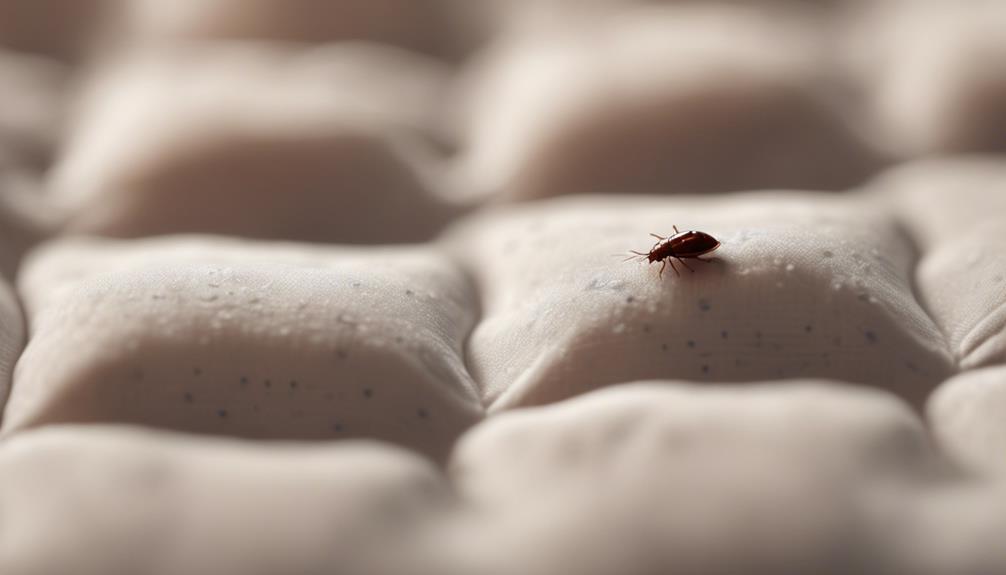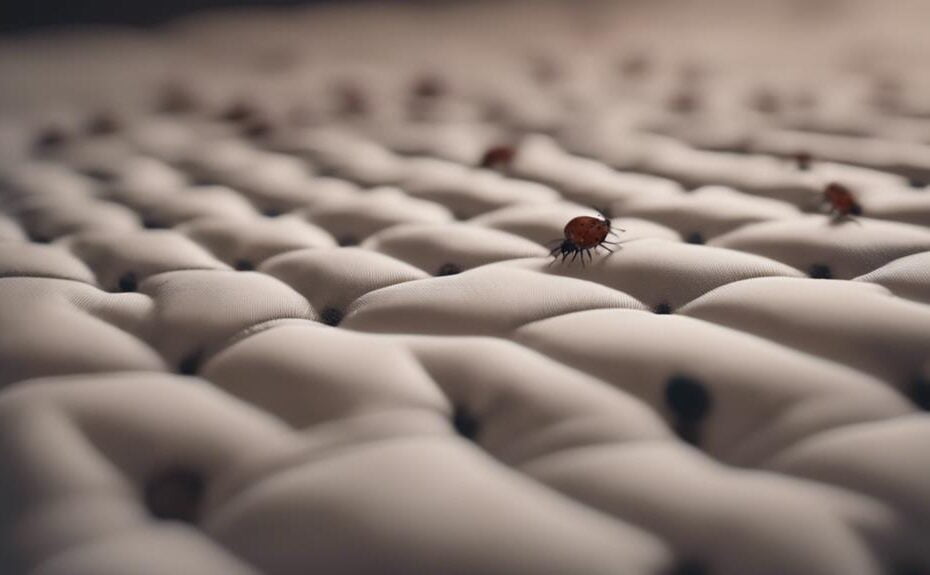When it comes to the presence of bed bugs, being able to recognize the signs of an infestation is crucial. These elusive pests are adept at hiding in cracks and crevices, making their detection a challenging task.
Understanding what a bed bug infestation looks like goes beyond merely spotting the insects themselves. By exploring the key indicators, such as physical appearance, bites on the skin, and the presence of their eggs, one can gain valuable insights into the extent of the infestation.
However, the true manifestation of a bed bug infestation may surprise you, prompting a closer examination of your surroundings.
Physical Appearance of Bed Bugs
The physical characteristics of bed bugs, known scientifically as Cimex lectularius, play a crucial role in their identification and detection. Understanding the bed bug lifecycle is essential for effective control and prevention strategies. Bed bugs are small, oval-shaped insects with a reddish-brown color. They have flat bodies that swell and turn a deeper red after feeding on blood. Adult bed bugs typically grow to about 5-7 millimeters in length. Their bodies are segmented, and they have six legs, antennae, and vestigial wings that do not allow them to fly.
To prevent bed bug infestations, various strategies can be employed. Regularly inspecting living spaces for signs of bed bugs, such as their exoskeletons or fecal spots, can help detect infestations early. Additionally, minimizing clutter in living areas can reduce potential hiding spots for bed bugs. Sealing cracks and crevices in walls, floors, and furniture can also help prevent bed bugs from entering and establishing infestations. Proper hygiene practices and frequent washing of bedding and clothing in hot water can further deter these pests. By understanding the physical appearance of bed bugs and implementing preventive measures, infestations can be managed effectively.
Bed Bug Bites on Skin
Upon emerging from their hiding spots to feed, bed bugs leave behind distinct bite marks on the skin of their human hosts. These bites often appear as small, red welts or bumps and are typically found in clusters or a line pattern on areas of the body that are exposed during sleep, such as the face, neck, arms, and hands. The bites themselves are usually painless at first but may develop into itchy, red, and inflamed areas over time. Some individuals may also experience allergic reactions to bed bug bites, leading to more severe symptoms.
To highlight the different aspects of bed bug bites, the following table summarizes key points:
| Aspect | Description | Treatment Options |
|---|---|---|
| Appearance | Small, red welts or bumps in clusters | Topical corticosteroids, antihistamines, or calamine lotion |
| Symptoms | Itching, redness, inflammation | Oatmeal baths, cold compresses, oral antihistamines |
| Allergic Reactions | Severe swelling, blistering | Seek medical attention for possible steroid treatment |
| Prevention | Regular inspection, use of mattress encasements | Reduce clutter, vacuum frequently, seal cracks and crevices |
Signs of Bed Bugs in Your Home

Emerging beyond the realm of bed bug bites on the skin, a keen awareness of the signs indicative of a bed bug infestation within one's home is paramount in effectively addressing these unwelcome pests.
One common sign is the presence of dark or rusty spots on bedding, mattresses, or furniture, which are fecal stains left behind by bed bugs. Additionally, small bloodstains on sheets may indicate bed bug activity.
Another sign is the shed exoskeletons of bed bugs, which they discard as they grow in size. Musty, sweet odors in the room can also be a sign of a large bed bug population.
Prevention methods such as regularly inspecting and cleaning bedding, vacuuming carpets and furniture, and sealing cracks and crevices can help reduce the likelihood of an infestation.
In case of an infestation, treatment options include professional pest control services, heat treatments, vacuuming, and the use of insecticides specifically designed for bed bugs. Regular monitoring and swift action are crucial in managing bed bug infestations effectively.
Bed Bug Eggs and Nymphs
Observing bed bug eggs and nymphs can provide valuable insights into the reproductive cycle and growth stages of these persistent household pests. Bed bug eggs are tiny, about the size of a pinhead, and are usually white or pearl in color. The egg hatching process typically takes around 6 to 10 days, depending on environmental conditions such as temperature and humidity. Once hatched, bed bug nymphs emerge, resembling miniature versions of adult bed bugs but lighter in color and translucent.
Nymph development is crucial in understanding the bed bug lifecycle stages. Nymphs go through five molts before reaching adulthood, requiring a blood meal between each stage to grow and develop. These nymphs can be as small as 1mm and are difficult to spot with the naked eye. As they mature, they darken in color and become more visible.
Identifying bed bug eggs and nymphs is crucial in determining the extent of an infestation and understanding how these pests spread within a home. Regular inspections and early detection can help prevent a small infestation from becoming a larger, more challenging problem.
Identifying Bed Bug Infestation in Beddings

Bed bug infestations in beddings can be identified through careful examination for signs of fecal stains, shed exoskeletons, and live bugs. Bed bug droppings, also known as fecal stains, are small dark spots that resemble ink stains on fabric. These stains are usually found along mattress seams, bed frames, and other hiding spots where bed bugs reside. Shed exoskeletons are another indicator of a bed bug infestation. As bed bugs grow from nymphs to adults, they molt and leave behind translucent exoskeletons. These can be found in the seams and crevices of mattresses and other furniture. Lastly, live bugs themselves are a definitive sign of an infestation. Bed bugs are reddish-brown, oval-shaped insects about the size of an apple seed. They are most active at night and can often be seen scurrying around bedding and nearby areas.
| Signs of Infestation | Description |
|---|---|
| Fecal Stains | Small dark spots resembling ink stains |
| Shed Exoskeletons | Translucent exoskeletons left behind during molting |
| Live Bugs | Reddish-brown, apple seed-sized insects |
Frequently Asked Questions
How Quickly Can a Bed Bug Infestation Spread From One Room to Another in a Home?
Bed bug infestations can spread rapidly from one room to another in a home, facilitated by the insects' ability to move through cracks, crevices, and electrical outlets. To prevent such spread, early detection is crucial.
Once identified, immediate containment measures should be implemented to prevent further migration. Eradication efforts should focus on thorough treatment of affected areas, including bedding, furniture, and walls, to effectively eliminate the infestation.
Can Bed Bugs Hide in Electronics or Other Non-Fabric Materials?
Bed bugs can indeed hide in electronics and other non-fabric materials. These pests are adept at seeking out small crevices and hiding spots, making electronic devices an attractive harborage for them.
As bed bugs do not solely rely on fabric for shelter, they can easily infest various items within a home, including electronics.
It is crucial to check all potential hiding places thoroughly to effectively address a bed bug infestation.
Are There Any Natural Remedies That Effectively Get Rid of Bed Bugs?
When addressing a bed bug infestation, natural remedies like essential oils, vinegar, heat treatment, and diatomaceous earth can be considered.
Essential oils like lavender, tea tree, and peppermint are believed to have repellent properties.
Vinegar can help disrupt bed bugs' pheromones.
Heat treatments above 120°F can be effective in killing bed bugs.
Additionally, diatomaceous earth, a natural substance, can be used to dehydrate and kill bed bugs.
How Long Can Bed Bugs Survive Without a Blood Meal?
Bed bugs can survive for several months without a blood meal, depending on environmental conditions. Their feeding habits are crucial to their survival and reproduction cycle.
These insects typically feed every 5-10 days, but can endure longer periods without blood. The ability to withstand starvation enables bed bugs to remain hidden during dormant periods, making eradication challenging.
Understanding their survival duration without a blood meal is essential for effective pest control strategies.
Can Bed Bugs Infest a Car or Other Vehicles?
Vehicle infestation by bed bugs is possible, as these pests can hide in small crevices. To prevent infestations, regularly inspect and clean vehicles.
Extermination methods for cars include vacuuming thoroughly, steam cleaning, and using insecticides approved for automotive use. Additionally, heat treatments can be effective in eradicating bed bugs from vehicles.
It's crucial to address any infestation promptly to avoid spreading the pests to other areas.
Conclusion
In conclusion, the presence of bed bugs in a home can be identified through physical appearance, bites on the skin, signs in the environment, eggs, nymphs, and infested beddings.
The irony lies in the fact that these tiny pests can cause immense discomfort and distress to individuals, despite their small size.
It is important to promptly address any signs of a bed bug infestation to prevent further spread and potential health risks.

